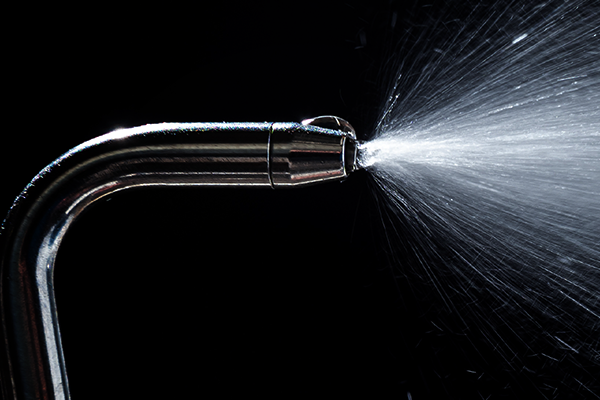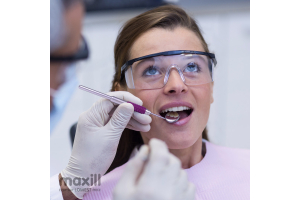Dental Aerosol Containment: Best Practices

The oral cavity contains over 700 species of bacteria in dental plaque along with other potentially pathogenic microbes, including viruses and fungi from the pulmonary system and nasopharynx.3 These pathogens are spread readily by coughing, talking, and sneezing.
The Centers for Disease Control has confirmed that the spread of oral bacteria is increased through aerosol-generating procedures (AGP) in clinical settings for dental healthcare providers and our patients.1,5 Aerosol-generating procedures include treatments using high-speed turbine drills, ultrasonic scalers, air-polishers, and air-water syringes. This equipment mixes air and water into an aerosol and can propel the particles for some distance.
Dental treatment involves close, face-to-face interaction with our patients and, along with AGPs, increases the exposure of our mouth, skin, mucous membranes, eyes, and respiratory system to pathogenic microbes. Environmental surfaces and materials can also be contaminated by aerosol and droplet contamination.
The Occupational Safety and Health Association (OSHA) Bloodborne Pathogen Standard has, for many years, made us keenly aware of the need for hazard controls to be put into place to prevent, avoid, and report exposure to bloodborne pathogens. The COVID pandemic has increased awareness of other disease transmission risks our profession may encounter, such as airborne person-person or indirect contact transmission. Although COVID is at the forefront of our thoughts, we cannot forget that the common cold, rhinovirus, and influenza are also spread by airborne transmission.
What is an aerosol?
Aerosols are liquid or solid droplets and debris less than 50 micrometers in diameter consisting of components of saliva, nasopharyngeal secretions, plaque, blood, and tooth particles. Droplets range from 11-50 micrometers, and droplet nuclei are 10 micrometers or less. Most aerosols in the dental office are less than 5 micrometers.
What are the risks to our health?
These droplets can contaminate surfaces to a range of 3 feet and can be suspended in the air for 30 minutes to 2 hours. Some studies have reported that viruses within the settled droplets can remain viable for days on fomite surfaces and increase the chance of disease spread through indirect contact. Also, the small size of some aerosolized particles can enter deep into the lungs through inhalation and cause infection.3
What infection control best practices can we integrate into our offices to keep our patients and dental personnel safe from respiratory disease transmission?
In 2020, the CDC, ADA, and CDA recommended that offices post-pone elective dental procedures. The offices complied, but it was clear that this was not sustainable. Our dental procedures cannot be limited to methods free from aerosol production. Dental offices must be aware of the "unseen" airborne risks within their operatories and follow infection control mitigation recommendations before, during, and after patient care. The CDC, ADA and CDA recommendations for infection prevention and control included, among other things, that for an asymptomatic patient:
- If the procedure is unlikely to produce an aerosol, dental personnel can use routine PPE for low-risk procedures
- If aerosols are likely to be produced, the following PPE standards are recommended:
- N95 or higher-level respirator mask
- Full face shields or goggles
- Gloves
- Disposable gown (In Canada Level 2 minimum for fluid resistance)
- Head coverings
- Appropriate hand hygiene and cleaning/disinfecting of clinical surfaces with a Health Canada/EPA-registered intermediate level disinfectant
RELATED Controlling the Chain of Infection in Your Dental Office
PPE is necessary for infection control, but if the aerosol can be reduced at the sight of formation, the risk of disease transmission becomes significantly lower. The most significant reduction in aerosol production at the site of formation is by the proper use of a high-volume evacuator (HVE) .
Using a dental dam in combination with HVE during restorative procedures and endodontic therapy also reduces aerosol production.
High-volume evacuators in dental offices have a large opening of 8 millimeters or greater. This large opening allows the evacuator to remove liquid and large volumes of air (up to 100 cubic feet of air per minute); this combination can remove at least 90 % of aerosolized particles. Saliva ejectors do not have this feature, so they are not considered proper equipment for aerosol control 4. For the most effective management of aerosols by use of HVE, the opening of the tip is placed 6-15 mm away from the dental handpiece or ultrasonic scaler.
Dental Devices and Procedures Known to Produce Airborne Contamination2
| Dental Devices/Procedures | Airborne Contamination Potential | Potential Mitigation for Droplet/Aerosol |
|
Ultrasonic Scaler |
Considered to be the most significant source of aerosol contamination in dental practice |
High-volume evacuation during powered scaler use reduces airborne contamination by > 95% |
|
Air polishing |
Airborne bacterial counts indicate aerosol production nearly as high as with ultrasonic scalers |
High-volume evacuation during powered scaler use reduces airborne contamination by > 95% |
|
Air-water syringe |
Airborne bacterial counts indicate aerosol production nearly as high as with ultrasonic scalers |
High-volume evacuation during use reduces airborne contamination by > 99% |
|
Tooth preparation with air-turbine handpiece |
Minimal airborne contamination if the proper placement of a rubber dam is in place |
The use of a rubber dam and high-volume evacuation is indicated, which minimizes airborne contamination |
What about other evacuation devices?
Various other evacuation equipment is available such as hands-free isolation devices. These devices provide evacuation of liquid, keep the patient's mouth open while retracting the tongue, and provide some containment of dental aerosols. However, a study report published in the Journal of the American Dental Association compared a saliva ejector to an isolation device. When examining the amount of aerosol and splatter reduction following ultrasonic scaling, neither device effectively reduced aerosols or splatter.3 High-volume evacuators remain the most effective aerosol containment device available for our use.
To Sum it Up
Dentistry needs the use of ultrasonic scalers, air polishers, and dental handpieces to perform our treatments properly. Professional health and safety recommendations are regularly developing, and we must continue to seek the most evidence-based information for proper infection prevention against the many forms of disease transmission challenging us today.
References
- Guidance for dental settings. Interim infection prevention and control guidance for dental settings during the COVID-19 response. https://www.cdc.gov/coronavirus/2019-ncov/hcp/dental-settings.html Date accessed: July 18, 2022
- Harrel SK, Molinari J. Aerosols and splatter in dentistry: a brief review of the literature and infection control implications. J Am Dent Assoc. 2004 Apr;135(4):429-37. doi: 10.14219/jada.archive.2004.0207. PMID: 15127864; PMCID: PMC7093851.
- Kumbargere Nagraj S, Eachempati P, Paisi M, Nasser M, Sivaramakrishnan G, Verbeek JH. Interventions to reduce contaminated aerosols produced during dental procedures for preventing infectious diseases. Cochrane Database Syst Rev. 2020 Oct 12;10(10):CD013686. doi: 10.1002/14651858.CD013686.pub2. PMID: 33047816; PMCID: PMC8164845.
- Holloman JL, Mauriello SM, Pimenta L, Arnold RR. Comparison of suction device with saliva ejector for aerosol and splatter reduction during ultrasonic scaling. J Am Dent Assoc. 2015;146(1):27-33.
- Coronavirus (COVID-19) Guidance for Acute, Long Term, Community and Dentistry Care https://ipac-canada.org/guidance-for-ltc-community-and-dentistry.php Date accessed: July 18, 2022







